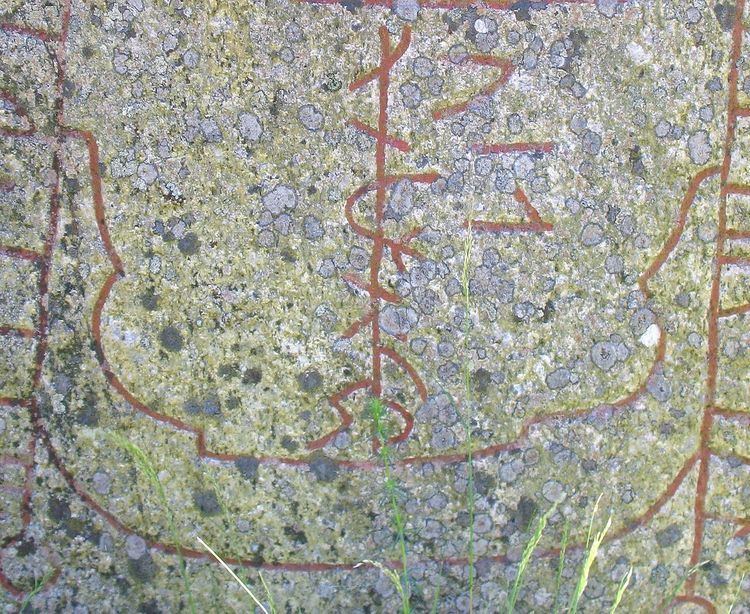A bind rune (Icelandic: bandrún) is a ligature of two or more runes. They are extremely rare in Viking Age inscriptions, but are common in earlier (Proto-Norse) and later (medieval) inscriptions.
On some runestones, bind runes may have been ornamental and used to highlight the name of the carver.
There are two types of bind runes. Normal bind runes are formed of two (or rarely three) adjacent runes which are joined together to form a single conjoined glyph, usually sharing a common vertical stroke (see Hadda example below). Another type of bind rune called a same-stave rune, which is common in Scandinavian runic inscriptions but does not occur at all in Anglo-Saxon runic inscriptions, is formed by several runic letters written sequentially along a long common stemline (see þ=r=u=t=a=R= =þ=i=a=k=n example shown above). In the latter cases the long bind rune stemline may be incorporated into an image on the rune stone, for example as a ship's mast on runestones Sö 158 at Ärsta and Sö 352 in Linga, Södermanland, or as the waves under a ship on DR 220 in Sønder Kirkeby, Denmark.
Examples found in Elder Futhark inscriptions include:
Stacked Tiwaz runes: Kylver Stone, Seeland-II-CGebô runes combined with vowels: Kragehul IThe syllable ing written as a ligature of Isaz and Ingwaz (the so-called "lantern rune").Bind runes are not common in Anglo-Saxon inscriptions, but double ligatures do sometimes occur, and triple ligatures may rarely occur. The following are examples of bind-runes that have been identified in Anglo-Saxon runic inscriptions:
The word gebiddaþ is written with a ligatured double ᛞ (dd) on the Thornhill III rune-stoneThe name Hadda is written with a ligatured double ᛞ (dd) on the Derbyshire bone plateThe word broþer is written with a ligatured ᛖ and ᚱ (er) on some Northumbrian stycasThe Latin word meus is written as mæus with a ligatured ᛗ and ᚫ (mæ) on the Whitby combThe inscription [h]ring ic hatt[æ] ("ring I am called") is written with a ligatured ᚻ and ᚪ (ha) on the Wheatley Hill finger-ringThe names of the evangelists, Mat(t)[h](eus) and Marcus are both written with a ligatured ᛗ and ᚪ (ma) on St Cuthbert's coffinThe name Dering may be written with a triple ligatured ᛞ, ᛖ and ᚱ (der) on the Thornhill III rune-stone (this reading is not certain)The word sefa is written with a ligatured ᚠ and ᚪ (fa) on the right side of the Franks CasketLigatured ligatured runes ᛖᚱ (er), ᚻᚪ (ha) and ᛞᚫ (dæ) occur in the cryptic runic inscription on a silver knife mount at the British MuseumThe word gægogæ on the Undley bracteate is written with ligatured ᚷ and ᚫ (gæ) and ᚷ and ᚩ (go)A ligatured ᚾ and ᛏ (nt) occurs in the word glæstæpontol on a cryptic inscription on a silver ring from Bramham Moor in West YorkshireA triple ligature ᛞ, ᛗ and ᚩ (dmo) occurs on a broken amulet found near Stratford-upon-Avon in 2006. This is the only known certain Anglo-Saxon triple bind rune. There is possibly a faint ᛖ, ᛞ (ed) bind rune on the reverse of the amulet.The Bluetooth logo merges the runes analogous to the modern Latin alphabet letters h and b; ᚼ (Hagall) and ᛒ (Berkanan) together, forming a bind rune. The two letters form the initials 'H B', alluding to the Danish king and viking raider Harald Bluetooth.The former logo of Thor Steinar featured a combination of a *tiwaz rune (ᛏ) and a *sowilo rune ᛋ. This logo caused controversy as the runes were so combined that a part of the logo became very similar to the insignia of the Schutzstaffel.
